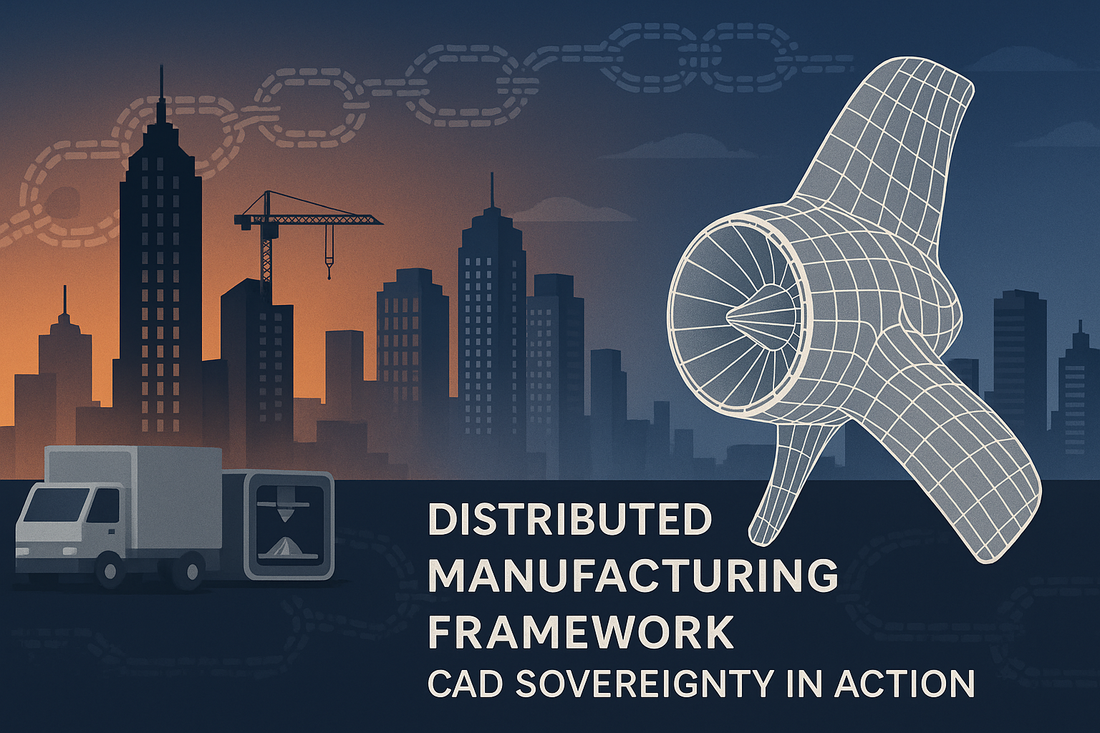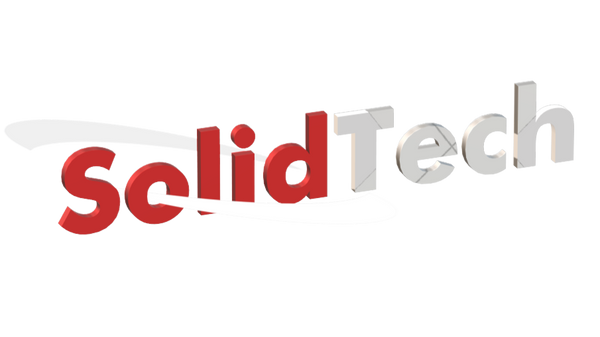
Distributed Manufacturing Framework (DMF): CAD Sovereignty, Additive Manufacturing, and Blockchain Logistics in India and Brazil
Share
Distributed Manufacturing Framework (DMF): CAD, Additive Manufacturing, and Blockchain Logistics in India and Brazil
Author: Benjamin Marino
Abstract
This paper proposes a Distributed Manufacturing Framework (DMF) as a conceptual model for post-PLM, on-chain manufacturing. The DMF integrates three components into a unified system: sovereign computer-aided design delivered as a SaaS platform, additive manufacturing hubs specializing in ceramics and composites, and courier-integrated logistics secured by blockchain and proof-of-location protocols. While broadly applicable, India and Brazil currently meet the most comprehensive set of metrics for early adoption, combining large user bases, maturing logistics infrastructures, and pressing infrastructure needs. Tuned Mass Damper Inerters (TMDIs) are proposed as the anchor product for a pilot implementation, linking CAD autonomy to distributed additive manufacturing and national building codes. DMF illustrates how geometric sovereignty converts economically by reducing freight emissions, strengthening resilience, and opening scalable, exportable production pathways.
Keywords Additive Manufacturing; Computer-Aided Design; Post-PLM Systems; Distributed Production; Blockchain Logistics; Tuned Mass Damper Inerters; India Industrial Policy; Brazil Manufacturing Strategy
Scope
Computer-aided design is a software tool but also the operative geometry that defines production capacity. In this sense, CAD functions as a projection of what can and cannot be manufactured. Yet despite its centrality, CAD remains both undervalued and inaccessible to much of the world. Over the last two decades, market leaders shifted from perpetual licensing to subscription models. This transition has been well documented in industry surveys and trade press, showing how licensing regimes moved from ownership toward mandatory renewals, extracting continuous revenue without proportional functionality gains. AEC Magazine notes that the subscription model boosted vendor revenues but has raised compliance risks and costs for customers. A 2017 survey from *Engineering.com* similarly found that the four most common complaints among users were high costs, lack of interoperability, steep learning curves, and insufficient skilled labor, reinforcing the perception of CAD as a burden as much as a tool. These structural issues have limited adoption in developing markets while entrenching dependency in advanced ones.
The global CAD market was valued at $12.71 billion in 2024 and is projected to reach $24.04 billion by 2033, growing at a compound annual growth rate of 7.34 percent. There are an estimated 45 million CAD users worldwide, with 38 percent of new installations in the Asia-Pacific region, particularly China and India. India alone accounts for 4.5 million CAD users as of 2023, with 1.6 million added through educational initiatives. Yet costs remain a significant barrier to entry: annual licensing fees for premium CAD systems average between $1,200 and $3,500 per seat, while training costs exceed $1,000 per employee. Penetration rates in regions such as Southeast Asia and Sub-Saharan Africa remain below 30 percent due to these financial constraints. The cumulative result is a global market in which CAD use is widespread but uneven, creating conditions where control of geometry effectively functions as control of production.
The Distributed Manufacturing Framework is designed to reorganize these dynamics. It rests on three elements brought together into a single system. First, a sovereign CAD platform deployed as SaaS provides the geometry layer. By detaching from vendor licensing and moving to a private service architecture, nations can secure control over their design capacity while maintaining accessibility. Second, additive manufacturing hubs supply the production layer. Ceramic and composite printing are particularly well-suited to safety- critical devices where stiffness, fatigue resistance, and thermal stability are essential. Industrial ceramic additive manufacturing platforms provide this capability in emerging markets such as India. Third, logistics is integrated on chain, creating an auditable path from design to delivery. Proof-of-location technologies such as FOAM, operating through LoRa protocols, can be applied to courier networks, allowing verification of routes and ensuring that distributed production is not only efficient but transparent.
India is the leading candidate for DMF implementation. Its combination of a large CAD user base, rapidly maturing courier infrastructure, low-cost skilled labor for post-processing, and policy momentum around self-reliance creates an environment where distributed production could scale rapidly. A pilot program requiring Tuned Mass Damper Inerters in tall buildings would create immediate domestic demand. These devices are geometry- sensitive and safety-critical, making them an ideal entry point for distributed additive manufacturing. By fabricating TMDIs on ceramic AM platforms, India could anchor its distributed production model in a mandated infrastructure component. Brazil meets the next most comprehensive set of metrics, with its dense urban centers, infrastructure expansion, and growing logistics sector providing similar opportunities. Other countries could attempt variations of the DMF, but structural barriers such as high labor costs make widespread early adoption unlikely.
Approach
The DMF can be demonstrated through a simple pilot. A scaled TMDI element can be printed on ceramic AM equipment, benchmarked against a baseline structure, and routed through a prototype on-chain CAD and courier system. This would show how autonomy of design, additive manufacturing, and blockchain logistics converge into a coherent workflow. Building codes mandating TMDIs would supply consistent demand, while integration into a privately managed CAD SaaS would guarantee long-term accessibility. This approach highlights the system’s economic logic: geometry as service, production as distributed infrastructure, sovereignty as control of design.
The environmental benefits of distributed production are measurable. By substituting freight and warehousing with local print-and-courier workflows, the DMF reduces fuel consumption, emissions, and wasted inventory. Market studies already show that CAD- integrated additive manufacturing can reduce prototyping costs by 50 percent and cycle times by 30 percent. More significantly, lifecycle assessments integrated into CAD systems have demonstrated the capacity to track carbon footprints across entire projects. One industry report notes more than 1,200 projects that have already applied such features, pointing toward a convergence between geometry control and emissions management. By aligning CAD sovereignty with climate goals, India and Brazil can position themselves as not only manufacturers but also providers of environmental solutions.
Obstacles & Limitations
Challenges remain. Kernel development for CAD, interoperability standards, and certification frameworks for safety-critical 3D printed parts are all necessary. Regulatory development will be particularly important in India and Brazil, both of which lag behind Europe and the United States in certifying additively manufactured components. The FOAM protocol has not yet been tested in manufacturing logistics, though it has demonstrated proof-of-location capacity in IoT contexts. In practice, courier devices would broadcast LoRa pings tied to a blockchain hash, creating an auditable trail from CAD dispatch to delivery. Opposing views must also be considered. Existing PLM vendors may attempt to incorporate blockchain features into their offerings, but such measures would reinforce vendor lock-in rather than address control. Open-source CAD systems such as FreeCAD or BRL-CAD provide valuable alternatives, but lack kernel maturity, interoperability standards, and widespread industry adoption, limiting their immediate suitability for sovereign deployment. Quality control in distributed manufacturing presents another obstacle: without harmonized certification frameworks, variability across hubs could undermine trust. These issues suggest that implementation would require not only technical development but also institutional innovation.
The costs of CAD development should also be addressed directly. Licensing proprietary systems drains capital annually with no asset buildup. Sovereign CAD, though expensive to build, creates durable assets, intellectual property, and autonomy. Regulatory approval for safety-critical applications could take five to ten years, but incremental steps such as TMDI pilots can establish the framework in advance. The DMF should therefore be seen not as an immediate replacement but as a staged reorganization of production. Limitations include untested FOAM integration in manufacturing, high initial CAD development costs, and
uncertain regulatory pathways. Nevertheless, these constraints do not undermine the core claim: that distributed, on-chain manufacturing is within reach, and that India—and secondarily Brazil—are uniquely suited to establish it.
Conclusion
The Distributed Manufacturing Framework demonstrates how control of geometry can translate into control of production. By combining sovereign CAD, additive manufacturing hubs, and on-chain courier integration, the DMF reorganizes production into a transparent and distributed model. India is most strongly positioned to employ this approach, with Brazil following closely behind. The TMDI pilot provides a concrete entry point that links command of geometry with safety-critical infrastructure. The environmental benefits further reinforce the logic of this system, showing how emissions reductions can be embedded directly into design and production.
References
AEC Magazine. “CAD software licensing: from perpetual to subscription.” 2024. *Engineering.com*. “4 Things Users Hate Most About Their CAD Systems.” 2017. Market Growth Reports. “CAD Market Size, Growth & Industry Report 2024–2033.” 2024. Novedge Blog. “The Evolution of CAD Software: From Perpetual Licensing to Subscription Models.” 2024. FOAM Protocol. “Proof of Location: Technical Overview.” 2019. Westkämper, E. “Digital Production and Manufacturing Systems.” CIRP Annals, 2006. Holmström, J., et al. “The direct digital manufacturing (R) evolution.” Journal of Manufacturing Technology Management, 2010.
